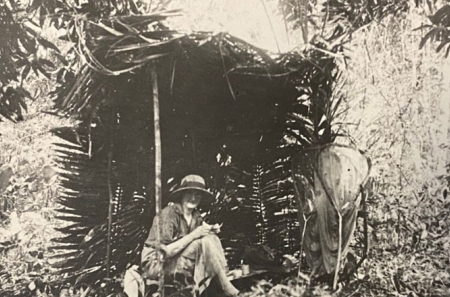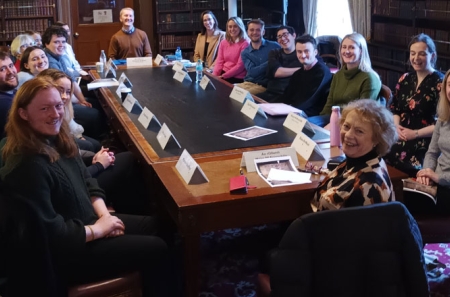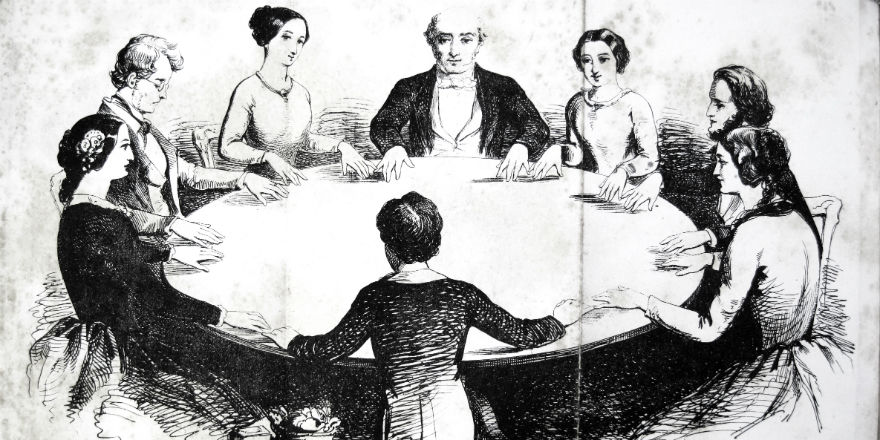
Table-Turning: a Victorian fad
24 October 2017This month’s Library Blog post delves into our nineteenth-century pamphlets to get readers into the spirit of Halloween.
“A Brief Guide to Table Turning:
Materials:
One small to medium sized wooden table
Two or more friends (four-five people is optimum)
One quiet room with dimmed lights
One sense of adventure / open mindMethod:
Sit around the table
Place hands on the table fingers spread
Ensure the room is quiet
Concentrate your mind on the answers you seek from the ‘other world’
Ask the spirits a question
Wait
The spirits should move or tilt the table
The tilting and moving should address the questions asked.”
‘Americans – that strange people, always fond of novelty.’[1]
Table turning also known as table-tilting or table-moving is a type of seance that became popular in America and Europe as a result of the actions of the soon to be notorious Fox sisters. In 1848 Kate and Margaret Fox, of Hydesville, New York, claimed they could communicate with spirits. This communication took the form of the spirits rapping or knocking. Typically one rap for yes and two raps for no in answer to a question and a series of raps to indicate letters of the alphabet.
The Fox sisters and their rappings soon became a local sensation and in 1849 they publicly demonstrated this phenomenon at the Corinthian Hall in Rochester, New York. This event played an important role in the creation of the Spiritualist movement. The use of a table worked in a similar way to a planchette on a Ouija board and became the conduit of choice for many people hoping to talk to those beyond the grave.
By 1852 the phenomenon had travelled beyond the afterlife and across the Atlantic to the tables of Europe. For the next few years it was practised in grand living-rooms, middle class parlours and humble kitchens. This sensation also came to the attention of scientists, doctors and clergymen who sought to investigate and explain the cause of these mysterious occurrences. Was there anybody there? Was it old aunt Mary communing from beyond the grave? Was it the work of the Devil? Or could it all be explained away by mere science?
These questions and investigations resulted in a flurry of pamphlets, books and newspaper articles, some of which survive in the RIA Library.
Practical instructions in Table-Turning
An 1853 pamphlet entitled Practical instructions in table-moving, with physical demonstrations begins with the origins of table-turning and the Spiritualist movement, calling it ‘the mysteries of a new religion.’[2] The author (‘A Physician’) then goes on to describe his experiments, detailing the optimum conditions needed for a successful session of table turning. His experiments brought him to the conclusion that persons with ‘a nervous constitution, coinciding with a perfect state of health is most favourable to table-moving.’[3] He also suggests a mix of genders as ‘The exquisite sensibility of woman joined with the strong will of man, constitutes one of the most favourable circumstances for the rapid manifestation of the phenomenon.’[4]
The author theorises that the phenomenon works as a result of a fluid, not yet discovered by science, and that it can not be compared to either ‘electricity, nor terrestrial magnetism.’[5] From a practical perspective he cautions that partaking in table-turning is not without its dangers as formerly inanimate furniture had sometimes fallen on the feet of the participants or been propelled across the room and made ladies faint.
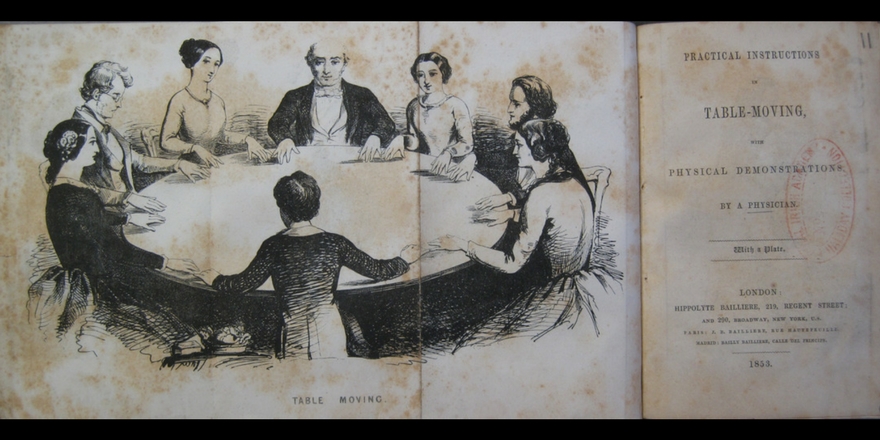
Practical instructions in table-moving, frontispiece (HP 2139/11)
Table-moving tested and proved to be the result of Satanic agency
Revd Nathaniel Stedman Godfrey of Wortley, Leeds, also took an interest in this sensation but, as a God-fearing gentleman, he turned to the Bible for answers. ‘Table-moving tested and proved to be the result of Satanic agency’[6] is one of a number of pamphlets on the subject written by the Revd Godfrey between 1853 and 1854. At quarter past nine on a Thursday night in June, the Revd Godfrey his wife and his curate sat down at a three-legged round mahogany table, about 12 inches in diameter. At ten o’clock the table began to move.
The household’s two maids and the National Schoolmaster were summoned to witness the event. The Revd Godfrey had begun his experiment with an air of scepticism and seemed surprised by the outcome. His detailed description of the session describes him asking questions of the table and the table answering via tilts and turns. The encounter ends when a Bible is produced and set upon the wayward table. He concludes that the movement of the table is not a manifestation of communion with the deceased nor the effects of electricity but is rather the work of the Devil. Having read the title of his pamphlet, his conclusion should come as no great surprise.
In reply to Revd Godfrey’s pamphlet, a number of clergymen published their own interpretations, arguing that Godfrey’s scriptural evidence was inconsistent and that there was no proof that Satan had the power of working miracles.
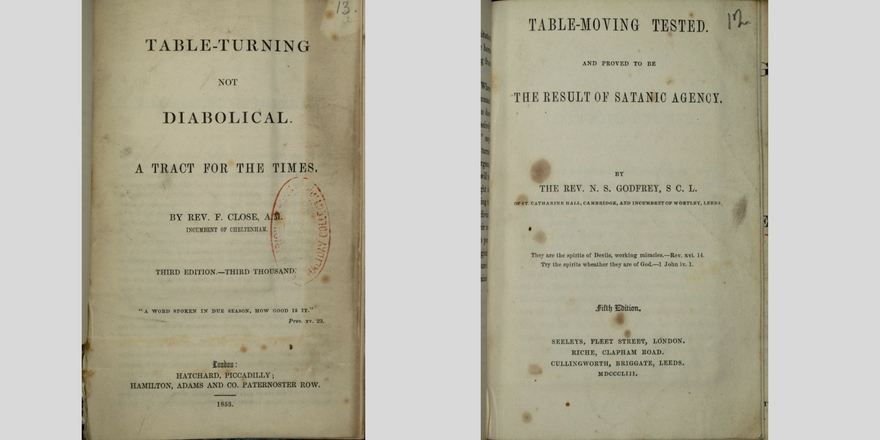
Table -turning not diabolical / By Rev. F. Close (HP 2139/13) Table-moving tested and proved to be the result of Satanic agency / by the Rev. N. S. Godfrey (HP 2139/12)
‘Table-turning’ and ‘Table-moving’ pamphlets were frequently reprinted
Faraday Investigates
Scientists were quick to question this unexplained phenomenon, some attributing the movement of the tables to electricity or magnetism. Due to his work in this area, the opinion of the renowned physicist Michael Faraday was sought. In 1853 Faraday conducted his own experiments and concluded that this was a physical phenomenon not a supernatural one. That the participants were unconsciously moving the table themselves by means of an ‘ideomotor response’. He made his findings and opinions public by writing a letter to The Times (London). ‘The first test apparatus: Faraday on table-turning’ was printed in the paper on 30 June 1853 and reprinted in various newspapers across the country and also in Ireland. Faraday’s letter was printed just as the Revd Godfrey was finalising his pamphlet. Undeterred by Faraday’s conclusions Godfrey added the following note at the end of his pamphlet:
‘While correcting this for the press, Professor Faraday’s letter was put into my hands. I merely notice it, to say that it has not the remotest bearing upon my experiments: ... as I am already in possession of independent testimony to its truth.’[7]
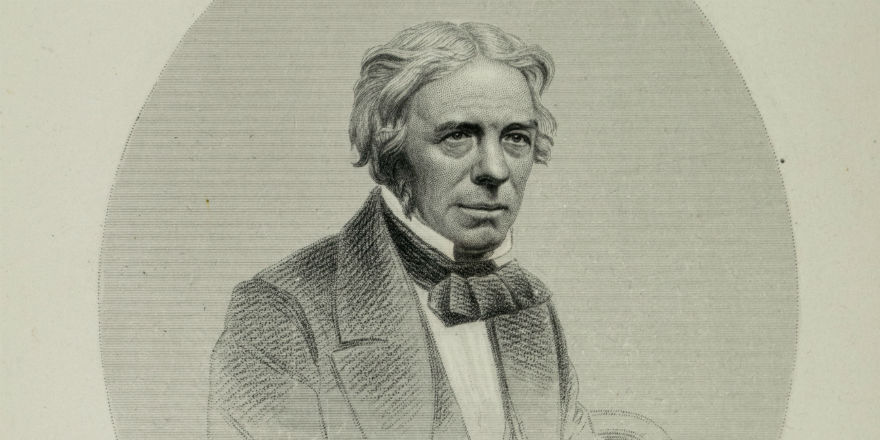
Portrait of Michael Faraday taken from Faraday as a discoverer / by John Tyndall, MRIA (London, 1868)
A true believer
John Ashburner was a respected doctor who had studied and practised in England, Ireland and Scotland. In 1815 he was elected as an Honorary Member of the Royal Irish Academy and for sometime lived on Frederick Street in Dublin. Later in his life he devoted his time to the study and practice of Mesmerism for healing purposes. He also became an enthusiastic proponent of Spiritualism and believed participants were truly communicating with spirits during table-turning sessions. In 1854 Ashburner became a writing medium (automatic writing) and claimed he had received messages from his father who had died in Bombay in 1808. Ashburner strongly disagreed with Faraday’s opinions on table-turning. Having met the scientist in London, Ashburner was not impressed, as is evident from the following scathing attack on Faraday’s character and intellect:
‘I was much struck with the want of philosophical acumen in Mr Faraday. I found him a vain man, with somewhat of a supercilious temper. His language, and the tone of his general bearing did not convey the idea of a man of enlarged mind.’[8]
In 1888 the Fox sisters admitted that it was all a hoax. They confirmed that the sensation that piqued the interest of Michael Faraday and sent tables spinning and rapping across two continents was in fact predicated on a lie. Yet the culture and practice of spiritualism survives confirming the fact that we really don’t know if there is ‘anybody there?’
Sophie Evans
Assistant Librarian
[1] A Physician, Practical instructions in table-moving, with physical demonstration (London, 1853)
[2] Ibid.
[3] Ibid.
[4] Ibid.
[5] Ibid
[6] N. S. Godfrey, Table-moving tested and proved to be the result of Satanic agency (London, 1848)
[7] Ibid.
[8] John Ashburner, MRIA, Notes and studies in the philosophy of animal magnetism and spiritualism, with observations upon catarrh, bronchitis, rheumatism, gout, scrofula, and cognate diseases (London, 1867)

